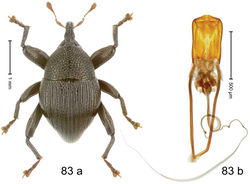Trigonopterus strigatus
| Notice: | This page is derived from the original publication listed below, whose author(s) should always be credited. Further contributors may edit and improve the content of this page and, consequently, need to be credited as well (see page history). Any assessment of factual correctness requires a careful review of the original article as well as of subsequent contributions.
If you are uncertain whether your planned contribution is correct or not, we suggest that you use the associated discussion page instead of editing the page directly. This page should be cited as follows (rationale):
Citation formats to copy and paste
BibTeX: @article{Riedel2013ZooKeys280, RIS/ Endnote: TY - JOUR Wikipedia/ Citizendium: <ref name="Riedel2013ZooKeys280">{{Citation See also the citation download page at the journal. |
Ordo: Coleoptera
Familia: Curculionidae
Genus: Trigonopterus
Name
Trigonopterus strigatus Riedel sp. n. – Wikispecies link – ZooBank link – Pensoft Profile
Diagnostic description
Holotype, male (Fig. 83a). Length 2.95 mm. Color black; antenna and tarsi ferruginous. Body ovate; in dorsal aspect almost without constriction between pronotum and elytron; in profile evenly convex. Rostrum in basal half with distinct median ridge and pair of submedian ridges, furrows with sparse rows of yellowish scales; apically weakly punctate, sparsely setose. Pronotum densely punctate-reticulate. Elytra dorsally with striae deeply incised forming well-defined furrows; intervals each with one secondary furrow of fused elongate punctures; laterally subglabrous, sparsely punctate. Femora somewhat widened, with distinct anteroventral ridge, edentate. Metafemur dorsally sparsely squamose with silvery scales; with weakly denticulate dorsoposterior edge; subapically with stridulatory patch. Metatibia apically with uncus, without premucro. Abdominal ventrite 5 with shallow depression, densely punctate, with dense suberect setae. Aedeagus (Fig. 83b) apically angulate, subglabrous; complex transfer-apparatus symmetrical; ductus ejaculatorius basally swollen, with indistinct bulbus. Intraspecific variation. Length 2.94–3.06 mm. Female rostrum in apical half slender, dorsally subglabrous, punctate, posteriorly with furrows. Female abdominal ventrite 5 densely punctate, with sparse recumbent scales, medially with weak swelling.
Material examined
Holotype (SMNK): ARC1188 (EMBL # HE615816), PAPUA NEW GUINEA, Morobe Prov., Huon peninsula, Mindik, S06°27.380', E147°25.099' to S06°27.267', E147°25.049', 1500–1650 m, 09-X-2009. Paratypes (ARC, NAIC, SMNK, ZSM): Morobe Prov., Huon peninsula, Mindik: 7 exx, ARC1189 (EMBL # HE615817), ARC1190 (EMBL # HE615818), same data as holotype; 4 exx, 1500–1670 m, S06°27.311', E147°24.073' to S06°27.221', E147°24.185', beaten, 10-X-2009; 1 ex (marked as ARC0060), 1200–1500 m, 26-IV-1998; 1 ex, 1400–1550 m, 27-IV-1998.
Distribution
Morobe Prov. (Mindik). Elevation: 1500 m.
Biology
Beaten from foliage of montane forests.
Etymology
This epithet is based on the Latin participle strigatus (striated) and refers to the species´ elytral sculpture.
Notes
Trigonopterus strigatus Riedel, sp. n. was coded as “Trigonopterus sp. 216” by Tänzler et al. (2012)[1].
Original Description
- Riedel, A; Sagata, K; Surbakti, S; Rene Tänzler, ; Michael Balke, ; 2013: One hundred and one new species of Trigonopterus weevils from New Guinea ZooKeys, 280: 1-150. doi
Other References
- ↑ Tänzler R, Sagata K, Surbakti S, Balke M, Riedel A (2012) DNA barcoding for community ecology - how to tackle a hyperdiverse, mostly undescribed Melanesian fauna. PLoS ONE 7 (1): e28832. doi: 10.1371/journal.pone.0028832
Images
|
